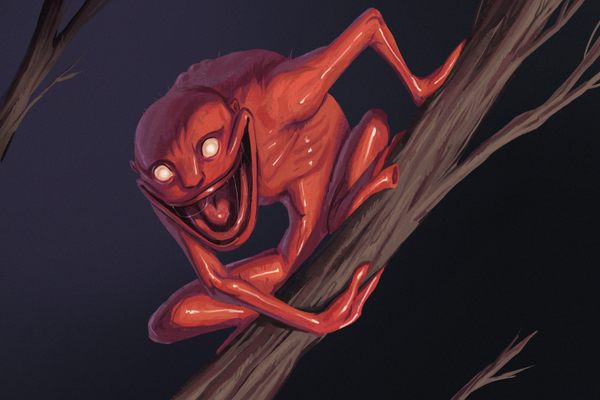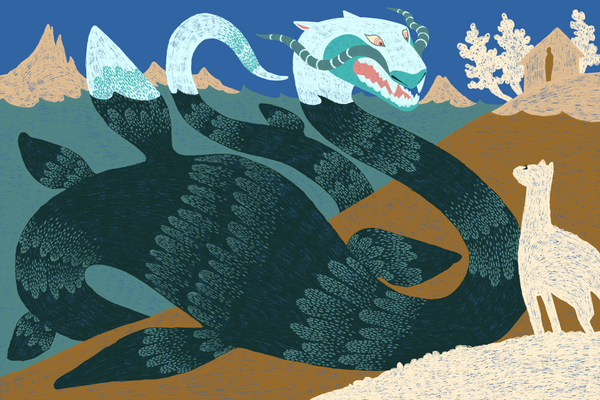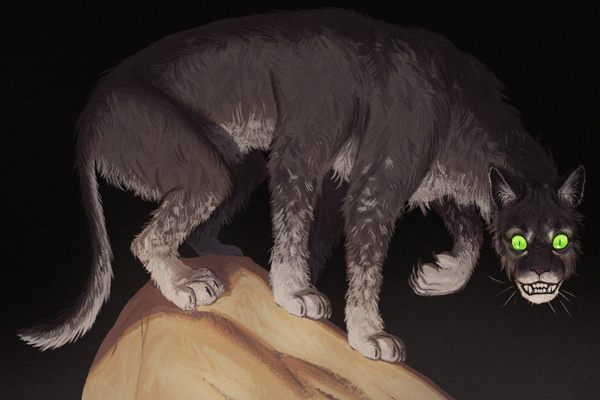The Blood-Sucking Capelobo Haunts Brazil’s Dense Forests
The humanoid anteater slurps its victim’s gray matter as if devouring termites in a mound.
It was just about 4 a.m. when an otherworldly scream cut through the forests lining the Xingu River in northern Brazil. A couple walking along a nearby road hurried to hide behind a rubber tree. From that vantage point, they could see a shadowy figure approaching them. As it grew closer, they recognized the outline of a man, but the creature was covered in animal hair and emitted a vile smell. It screamed again, its blood-curdling call echoing under the forest canopy, before disappearing into the trees. The only evidence it left behind was a row of perfectly round footprints in the dirt. The husband and wife would feel sick for days after the encounter as if poisoned by the noxious odor, but they had been spared a worse fate.
“It’s Capelobo! It’s Capelobo!” a Yudjá woman who witnessed this near meeting told her grandson some years later; he related the tale to a researcher in 2019. This capelobo had once been a man, but it was now a monster, prowling through the night feeding on human blood and brains (and also on puppies and kittens). Along the Xingu in the Brazilian state of Pará, a capelobo is said to resemble a humanoid tapir with a hooked snout. Along the Pindaré River in the state of Maranhão to the northeast, it looks more akin to an anteater, killing by sucking out its victim’s gray matter as if it were devouring termites in a mound.

Silivo Froes Abreu may have been the first to document tales of this creature on his expedition into Maranhão in the 1920s. The young scientist from Rio de Janeiro was there to study the potentially valuable babassu palm, but he also tasked himself with observing the region’s geography and the Indigenous people who called the land home. In the early 20th century, much of Brazil’s 3.3 million square miles remained a mystery to those of Portuguese descent who lived along the country’s coastline.
The Guajajara people didn’t want to tell a stranger their legends, Abreu wrote in Na terra das palmeiras in 1931. It was only with great difficulty that he learned about the feared beasts, which he called “cupélobo” and believed to be a variant on a werewolf, a supernatural predator common in Portuguese lore. (“Lobo” means “wolf’ in Portuguese.”) According to some stories, a capelobo was born when a very old man lost his senses and wandered into the forest. Soon he would start eating raw meat and be transformed. Unlike in many werewolf tales, he would never return to his human state.
As the 20th century progressed, anthropologists and folklorists would paint an even more terrifying portrait of the capelobo. Sometimes it had only one eye and no mouth, other times, only one leg, but it always had that piercing scream and an insatiable appetite. Luís da Câmara Cascudo, who would write some 8,000 pages on Brazilian folklore through the 20th century, described the creature as an evil being, a killing machine immune to all reason. A capelobo could only be stopped, it was said, by an arrow to the navel, hidden beneath its thick pelt.

Abreu reported the Indigenous people he spoke to believed the capelobo to be flesh and blood. After he described the caged animals of the Rio de Janeiro zoo to those who lived among wild animals, one listener reportedly asked if the zoo had a capelobo. Cascudo was more skeptical, dismissively noting the story to be most prevalent among those in the community who were addicted to alcohol. More modern researchers identify the capelobo as an Indigenous myth, a useful anthropomorphization of the unknown but very real dangers of the Brazilian forests.
In 1947, Luís da Câmara Cascudo wrote in Geografia dos mitos brasileiros that while the capelobo—corporal or supernatural—would always haunt hunters and frighten children in the river basins of the Pará and Maranhão, he did not believe its scream would ever be heard beyond the region. He did not account for the cryptozoologists of the internet, who have embraced the unlovable beast, creating statues, illustrations, stickers, and t-shirts featuring the brain-eater.
These modern depictions, however, often ignore the one thing Northern Brazil’s Indigenous people uniformly agree on in recorded tales—there is no safe way to encounter the monster. One must either hide from the capelobo or become its prey.














Follow us on Twitter to get the latest on the world's hidden wonders.
Like us on Facebook to get the latest on the world's hidden wonders.
Follow us on Twitter Like us on Facebook